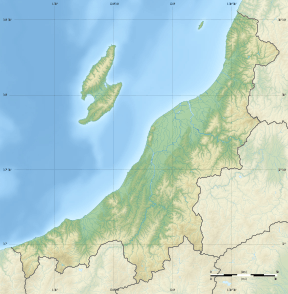Hida Sites
Hida ruins (斐太遺跡群, Hida iseki) is a group of archaeological sites containing the ruins of late Yayoi to early Kofun period settlements located in what is now part of the cities of Myōkō and Jōetsu, Niigata in the Hokuriku region of Japan. The site includes the Hida ruins (斐太遺跡)), Fukiage ruins (吹上遺跡) and the Kamabuta ruins (釜蓋遺跡)). The Hida ruins were designated a National Historic Site of Japan in 1977 and the Fukiage ruins and Kamabuta ruins followed in 2005.[1]
斐太遺跡群 | |
 Hida ruins  Hida Sites (Japan) | |
| Location | Myōkō and Jōetsu, Niigata, Japan |
|---|---|
| Region | Hokuriku region |
| Coordinates | 37°03′20″N 138°14′03″E |
| Type | settlement |
| History | |
| Periods | Yayoi period |
| Site notes | |
| Ownership | National Historic Site |
| Public access | None |
Overview
The Hida ruins in the city of Myōkō are located in a flat area on a hillside ridge with an elevation of approximately 40 meters, on the southwestern edge of the Kubiki Plain, and are divided into three areas. The foundations of 47 pit dwellings were discovered, with each dwelling having a diameter of between eight and ten meter for the larger, or 2 meters for the smaller on the north slopes of Mount Momoko, clustered into three groups. They attracted scholarly attention as they appear to have been abandoned at the end of the Yayoi period or start of the Kofun period, were excavated by the University of Tokyo from 1955-1958.
In 2005, the Fukiage ruins in the city of Jōetsu was added to the National Historic site designation. This was a village ruin from the middle Yayoi period, with a large scale workshop for making jadeite balls, which were used as pestles for grinding. The number of jadeite balls excavated is one of the largest in Japan. In addition, numerous stone knives and copper products that are rare in this area have also been discovered.
Kamabuta ruins was also a large village from the end of the Yayoi period to the beginning of the Kofun period. Many earthenware shards from distant areas, such as Omi to the west and the Kanto region to the east have been found. By its proximity to a river, it is though that the Kamabuta settlement was a trading settlement.
It is about a 10-minute drive from Arai Station on the JR Shinetsu Main Line to the Hida Ruins.
References
- "斐太遺跡群" (in Japanese). Agency for Cultural Affairs.
External links
- Myōkō city official site (in Japanese)
- Jōetsu city official site (in Japanese)